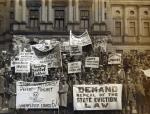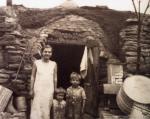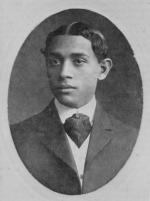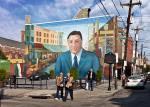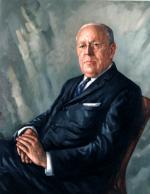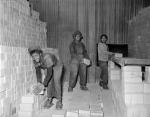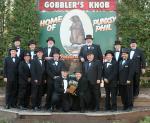Chapter 4: New Arrivals, 1930-present
Even amidst the struggles of economic hard times, and the uncertainties of war and international conflict, successive generations continued to identify with William Penn's ideal of a harmonious and well-ordered civil society. Nowhere was this more apparent than in October 1949, when tens of thousands of visitors gathered in a small town to commemorate the cooperative spirit behind
The Stock Market crash of October 1929 set off an economic collapse of an intensity and duration unprecedented in American history. Massive unemployment-25 percent nationwide in 1933 and as high as 37 percent in Pennsylvania-and a staggering decline in industrial output during the Great Depression persuaded many working-class Pennsylvanians to join unions . The economic challenges also forged new political alignments across the Commonwealth. Many working class, ethnic, and African-American voters bolted the Republican for the Democratic Party and President Franklin Delano Roosevelt's "New Deal," a move that transformed the state and the nation. Political participation followed in the wake of the Commonwealth's new social pluralism.
In the 1930s,
The political revolution of the 1930s opened doors that would widen in the decades that followed. In Philadelphia, for example, Bernie Samuel would become the first Jewish mayor in 1944, Frank Rizzo the first Italian-American mayor in 1972, and W. Wilson Goode, the city's first black mayor, in 1984.
After a decade of economic crisis, World War II jump-started Pennsylvania's industrial economy. New labor demand unleashed a second great wave of southern black migration to Philadelphia, Pittsburgh and milltowns in between. In Chester, 6,200 black workers labored in a segregated shipyard run by the
In the half-century following World War II, communities across the Commonwealth had to come to grips with serious social and economic changes, including industrial decline, white flight from urban centers, and an aging population left behind in once vibrant neighborhoods. Philadelphia, Pittsburgh,
Even in the face of economic decline and population stagnation, migration to Pennsylvania never ceased. After World War II, southern African Americans continued to move to Philadelphia, Pittsburgh, Harrisburg, York, and other Pennsylvania cities. Indeed, between 1940 and 1970, the state's African-American population soared from 470,000 to more than a million people. A new generation of black leaders, including
After the Immigration and Nationality Act of 1965 dismantled the rigid quota system put in place after World War I, Pennsylvania also attracted a new wave of immigrants, including Mexicans, Nicaraguans, and Hondurans from Latin America; Dominicans, Haitians, and Puerto Ricans from the Caribbean; Chinese, Japanese, Koreans, Vietnamese, Indians, and Indonesians from Asia; and Ethiopians, Nigerians, and Senegalese from Africa. In 1990, a quarter-million Pennsylvania residents claimed Hispanic origin and another 137,000 from parts of Asia. Thirty-six percent of this latest wave of migrants did not speak English as their first language.
From migrant workers in Adams and
Though no longer a major destination for foreign immigration to the United States, Pennsylvania remains a complex multicultural society. Indeed, in 2007, twelve states, led by California with more than 10 million, had more foreign-born residents. That year, Pennsylvania had just over 665,000 foreign-born residents. In 2005, 85 percent of Pennsylvania's 12.4 million inhabitants were of white European descent, roughly 10 percent were African American, 3.2 percent were Hispanic, and nearly 2 percent were Asian. Only .1 percent of Pennsylvanians identified themselves as "American Indian."
In the early twenty-first century, one of the state's oldest and most traditional immigrant groups experienced a remarkable resurgence. Even with rapidly escalating costs of farmland, and outmigration to Kentucky, Nebraska, and Indiana, Pennsylvania continues to have the nation's largest Amish population. Lancaster County still records the largest Amish population of any county in America: 29,535 out of the national total of 249,495. A formidable 85 percent of Amish youth remain within the community.
In recent decades, too, old customs and rituals have become the fodder of new heritage tourism initiatives. The old German custom reincarnated each February as
The search for a usable and meaningful past has embraced Pennsylvania's rich social and cultural history in new and unexpected ways. Polka festivals, Mummer Parades, Puerto Rican carnivals, Cinco de Mayo celebrations, American-Indian powwows, and Molly Maguire Days are all part of the human instinct to keep heritage and culture alive in twenty-first century Pennsylvania.






